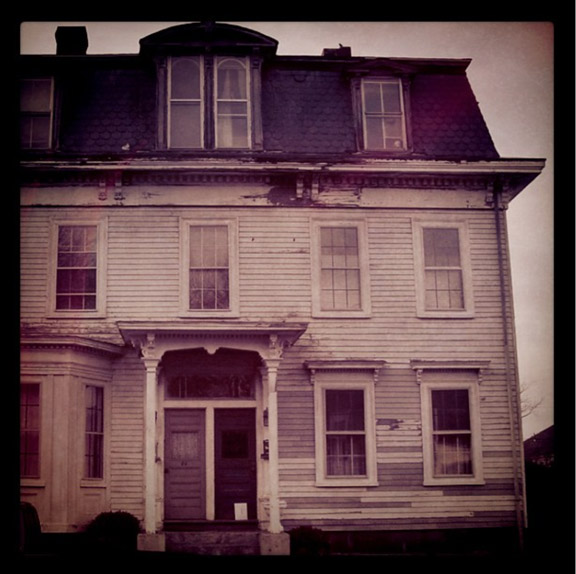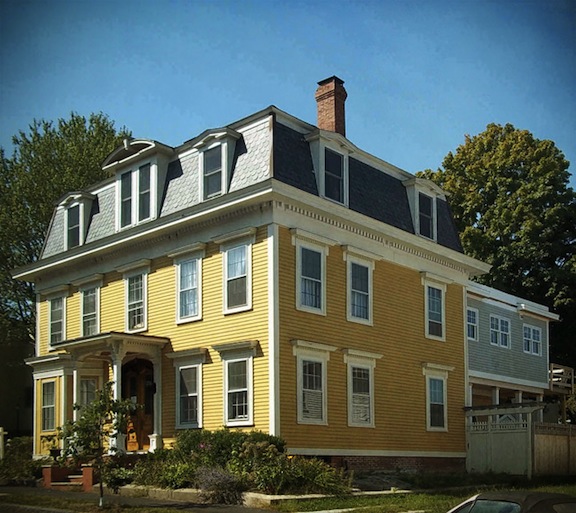This is Alex Dardinski’s reply on Facebook to an earlier post of mine, “Newburyport is Losing its Patina, and Historic Preservation.”
“I don’t want to live in Williamsburg, but in a tapestry of history rather than a single place in time.”
I think about this concept all the time in my work life designing products, as well as my personal life, restoring a historic Newburyport home — how to balance the love of new with the love of old? The term I always come back to is “palimpsest,” which in architectural terms would be the traces of the many years of use and reuse upon a facade or plan.
I struggle with the notion of doing a perfect museum grade restoration for many of the reasons that you have stated. I have lead paint concerns with my young family. I want a more open plan than the carpenters of the 19th century could provide. I want to have some modern conveniences too. I also want my house to have some patina, some soul. A connection to its past with real quality materials that were crafted when the house was built. The best find I ever made in my house was evidence that my house was “converted” from a square 2 story box into a stately 3 story second empire victorian by the Caldwell Rum family. That was an earth shattering revelation. I wonder how controversial that was at the time. It was a pure case of gentrification, circa 1870! But that is my favorite detail about my house and that part of its history makes me love it even more.
We MUST have some essential historic protections and zoning that keeps the character of our city intact. But I don’t want to live in Williamsburg either, but in a tapestry of history rather than a single place in time.
The first room I renovated when I was 25 years old was truly in need of a gutting. It was heavily water damaged and the horsehair plaster was falling off the walls. I took out the plaster, accidentally destroyed most of the trim, then went the lath, then I added modern insulation and rewired it all. It was 100% new. Now that is the most soulless sheetrock clad room in my house. So since that overreach, I have tried to fix real problems more surgically. Leaving many traces of the past as I go, knowing that in 100 years the work I do today will be part of the historic archive too — that the work of every tradesperson that will have touched my house adds to the “palimpsest” of the house.
On a larger scale, that is the story of Newburyport. The first period houses sat far apart from one another on large tracts of land. You see houses that once fronted the river, but now are 2 or more blocks away from the banks. They might face the wrong way from the street and seem odd until you close your eyes and imagine the wide open acres that separated these early structures from one another, long before the streets were fully laid out.
Second period houses came and filled in the density of our historic neighborhoods. That early construction boom must have come as a shock, but it makes the density (and one could argue the sense of community we enjoy is because of it) of our little city. Mid century Italianates then Victorians that must have seemed like modernist heresy to the purely colonial streetscapes of the early 1800’s. But in retrospect where would we be without them today? They add such color to the fabric of the town. In the period following the depression and post industrial Newburyport, many bad architectural choices were made, largely out of poverty, and so many of them have been erased in our city’s recent evolution.
So I guess my image of “the right thing to do” on my house of for the town in general is also still evolving. But I know that every change came with controversy. We must recognize that the best changes stand the test of time and the worst most often do not. We won’t be a town of vinyl siding in 100 years. The good choices will stand and the McMansions and the other the hasty choices will be largely edited away. We will still be a historic town, a beautiful town. And the things happening today even if controversial will be but one part off the palimpsest of the city’s history.
Editor’s Note: Many thanks to Alex Dardinski for his thoughtful, informative and optimistic addition to The Newburyport Blog.

